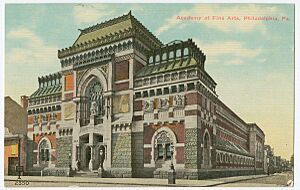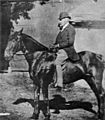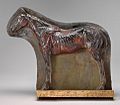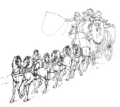Fairman Rogers facts for kids
Quick facts for kids
Fairman Rogers
|
|
|---|---|

Rogers c. 1890
|
|
| Born | November 15, 1833 |
| Died | August 22, 1900 (aged 66) |
| Alma mater | University of Pennsylvania |
| Occupation | civil engineer, educator, philanthropist |
Fairman Rogers (born November 15, 1833 – died August 22, 1900) was an important American engineer, a teacher, and someone who gave a lot of money to good causes. He was born in Philadelphia, Pennsylvania.
Contents
Fairman Rogers' Early Life and Education
Fairman Rogers went to the University of Pennsylvania and finished his studies in 1853. He loved learning and teaching, so he became a civil engineering professor there from 1855 to 1871. He was one of four professors who helped start the Department of Mines, Arts and Manufacturers in 1855. He also served as a leader for the university as a Trustee from 1871 to 1886. When he was a student, he helped create the Zeta Psi fraternity, Sigma chapter, in 1850.
Fairman Rogers' Career and Contributions
Fairman Rogers achieved a lot in his life. When he was just 24 years old, he became a member of the American Philosophical Society, a group of smart people who discuss ideas. He was also part of the Academy of Natural Sciences and a founding member of the National Academy of Sciences. He wrote a book called Terrestrial Magnetism and the Magnetism of Iron Ships, which was published in 1877 and updated in 1883.
Serving in the Civil War
During the American Civil War, Fairman Rogers volunteered to serve in the Union Cavalry. He worked with important generals like General John F. Reynolds and General William F. Smith. As an officer in the United States Army Corps of Engineers, he helped map the Potomac River in 1862. He also fought in major battles like Antietam and Gettysburg as part of the Pennsylvania militia.
After the war, he helped start the Union League of Philadelphia. He was also a member of the First Troop Philadelphia City Cavalry and later became its captain.
Working with Artists: Furness and Eakins
Fairman Rogers was very involved with the Pennsylvania Academy of the Fine Arts (PAFA). He led the committee that chose the design for the new museum and art school building in 1871. The winning design came from a new firm called Furness & Hewitt. Interestingly, Rogers's sister, Helen Kate, was married to Horace Howard Furness, who was the brother of the architect Frank Furness.

Rogers also worked to make PAFA a better place for all students. From 1878 to 1883, he was in charge of the Committee on Instruction. He made an important change by allowing women to study art at the Academy under the same rules and with the same chances as men.
He brought back a famous artist named Thomas Eakins to teach at the school. Rogers also asked Eakins to paint a very special picture called The Fairman Rogers Four-in-Hand (1879–80). This painting shows Rogers, his wife Rebecca, and their friends riding a carriage through Philadelphia's Fairmount Park. In 1882, Rogers promoted Eakins to be the director of PAFA's art school.
Rogers's favorite horse, "Josephine," who was the lead horse in the painting, died in 1882. He gave the horse's body to PAFA so Eakins and his students could study it. This helped Eakins create three special statues that showed the muscles of a horse, which were used as teaching tools.
In 1883, Rogers invited a photographer named Eadweard Muybridge to give a talk at PAFA. Muybridge was famous for his photos of animals in motion. This led Muybridge to move to Philadelphia and continue his research at the University of Pennsylvania's Veterinary School.
Fairman Rogers loved coaching, which is a sport where people drive horse-drawn carriages. He even started the Philadelphia Coaching Club. He wrote a very important guide about the sport called A Manual of Coaching in 1900.
Horace Howard Furness, Rogers's brother-in-law, wrote a book about him called F. R. [Fairman Rogers] 1833-1900. In 2007, the University of Pennsylvania had an exhibition called Equus Unbound: Fairman Rogers and the Age of the Horse, which showed items from his personal papers.
Fairman Rogers' Personal Life
Fairman Rogers hired Frank Furness to make changes to his home in Rittenhouse Square in 1871. Furness also designed "Fairholme" (1874–75), which was Rogers's summer house in Newport, Rhode Island. He also had a country house in Wallingford, Pennsylvania. Rogers later sold his city house, and Furness changed it for Alexander J. Cassatt in 1888.
Fairman Rogers and his wife did not have any children. They moved to Paris, France around 1890. Rogers passed away in Vienna, Austria in August 1900. He is buried in Laurel Hill Cemetery in Philadelphia.
Images for kids
-
Fairman Rogers astride his mare Josephine (1878), a photograph by Thomas Eakins.
-
The Mare "Josephine" - Écorché (c. 1882, painted plaster), by Thomas Eakins, at the National Gallery of Art, Washington, D.C.







